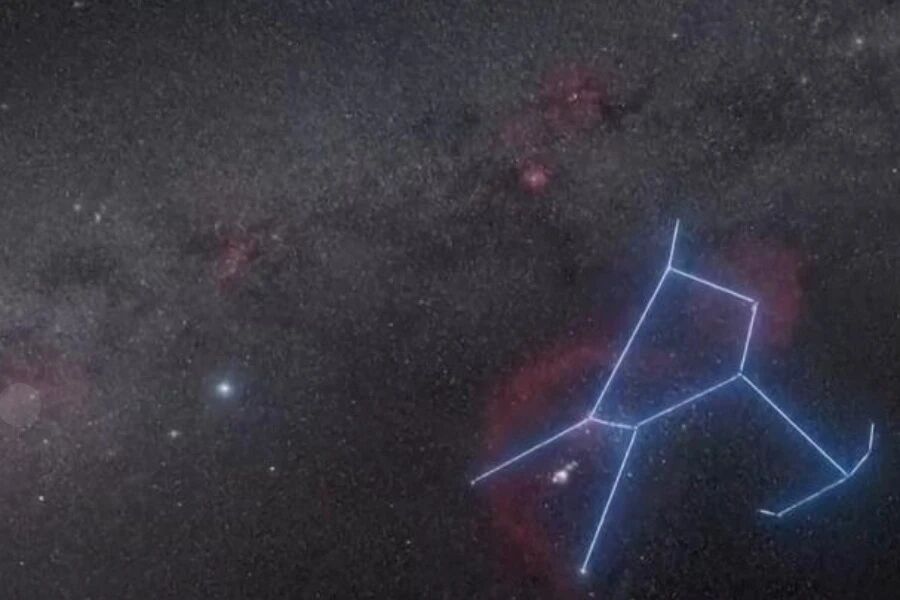Astronomers have discovered the earliest seeds of rocky planets forming in the gas around a baby sun-like star, providing a precious peek into the dawn of our own solar system.
天文学家在类太阳“幼年恒星”周围的气体中发现了岩质行星形成的最初迹象, 这为人们珍贵地一瞥我们自身太阳系诞生之初的景象提供了契机。

It's an unprecedented snapshot of "time zero," scientists reported Wednesday, when new worlds begin to gel.
科学家于周三报告称,这是对“时间零点”——新世界开始凝聚成形的时刻——前所未有的瞬间捕捉。
"We've captured a direct glimpse of the hot region where rocky planets like Earth are born around young protostars," said Leiden Observatory's Melissa McClure from the Netherlands, who led the international research team. "For the first time, we can conclusively say that the first steps of planet formation are happening right now."
“我们直接窥见到了类似地球的岩质行星在年轻原恒星周围诞生的炽热区域,” 领导该国际研究团队的荷兰莱顿天文台梅丽莎·麦克卢尔说, “我们首次可以确凿地说,行星形成的第一步正在发生。”
The observations offer a unique glimpse into the inner workings of an emerging planetary system, said the University of Chicago's Fred Ciesla, who was not involved in the study appearing in the journal Nature."This is one of the things we've been waiting for. Astronomers have been thinking about how planetary systems form for a long period of time," Ciesla said. "There's a rich opportunity here."
芝加哥大学的弗雷德·西斯拉表示,这些观测结果让人们得以一窥新兴行星系统的内部运作机制, 他并未参与发表在《自然》杂志上的这项研究。西斯拉说:“这是我们一直翘首以盼的事情。 天文学家长期以来一直在思考行星系统是如何形成的。” “这里蕴含着丰富的机遇。”
NASA's Webb Space Telescope and the European Southern Observatory in Chile teamed up to unveil these early nuggets of planetary formation around the young star known as HOPS-315. It's a yellow dwarf in the making like the sun, yet much younger at 100,000 to 200,000 years old and some 1,370 light-years away. A single light-year is 6 trillion miles.
美国国家航空航天局的韦伯太空望远镜与智利的欧洲南方天文台合作,揭示了围绕年轻恒星HOPS-315的行星形成早期迹象。 这颗恒星是一颗正在形成的类太阳黄矮星,但比太阳年轻得多,年龄在10万至20万年之间,距离地球约1370光年。 一光年即为6万亿英里。
In a cosmic first,McClure and her team stared deep into the gas disk around the baby star and detected solid specks condensing — signs of early planet formation. A gap in the outer part of the disk gave allowed them to gaze inside, thanks to the way the star tilts toward Earth.
麦克卢尔和她的团队首次在宇宙中深入观察了这颗幼年恒星周围的气体盘,并探测到了固体微粒的凝结,这是行星形成的早期迹象。 由于这颗恒星向地球倾斜,盘外缘的一个缺口使团队得以窥见其内部。
They detected silicon monoxide gas as well as crystalline silicate minerals, the ingredients for what's believed to be the first solid materials to form in our solar system more than 4.5 billion years ago. The action is unfolding in a location comparable to the asteroid belt between Mars and Jupiter containing the leftover building blocks of our solar system's planets.
他们探测到了一氧化硅气体和结晶硅酸盐矿物, 这些成分被认为是45亿多年前我们太阳系中形成的第一批固体物质。 这一过程正在一个与火星和木星之间的小行星带相当的位置展开,该小行星带包含了我们太阳系行星的剩余构建模块。
The condensing of hot minerals was never detected before around other young stars, "so we didn't know if it was a universal feature of planet formation or a weird feature of our solar system," McClure said in an email. "Our study shows that it could be a common process during the earliest stage of planet formation."
麦克卢尔在一封电子邮件中表示,此前从未在其他年轻恒星周围探测到过高温矿物质的凝结现象, “所以我们不知道这是行星形成的普遍特征,还是我们太阳系的独特特征。” “我们的研究表明,这可能是行星形成最早阶段的常见过程。”
While other research has looked at younger gas disks and, more commonly, mature disks with potential planet wannabes, there's been no specific evidence for the start of planet formation until now, McClure said.
麦克卢尔说,虽然其他研究已经观察过更年轻的星盘,以及更常见的、可能存在潜在行星候选体的成熟星盘, 但直到现在,还没有发现行星形成开始的具体证据。
In a stunning picture taken by the ESO's Alma telescope network, the emerging planetary system resembles a lightning bug glowing against the black void.
在欧洲南方天文台阿尔玛望远镜网络拍摄的一张令人惊叹的图片中, 这个新兴的行星系统就像一只在黑暗虚空中发光的萤火虫。
It's impossible to know how many planets might form around HOPS-315. With a gas disk as massive as the sun's might have been, it could also wind up with eight planets a million or more years from now, according to McClure.
目前无法确定HOPS-315周围可能会形成多少颗行星。 麦克卢尔表示,如果其气体盘与太阳曾经的气体盘一样巨大,那么在100万年或更长时间后,它也可能最终形成八颗行星。
Purdue University's Merel van 't Hoff, a co-author, is eager to find more budding planetary systems. By casting a wider net, astronomers can look for similarities and determine which processes might be crucial to forming Earth-like worlds.
该研究论文的合著者、普渡大学的梅雷尔·范特霍夫渴望发现更多新兴行星系统。 通过扩大搜索范围,天文学家可以寻找相似之处,并确定哪些过程可能对形成类地行星至关重要。
"Are there Earth-like planets out there or are we like so special that we might not expect it to occur very often?"
“那里是否存在类地行星,还是我们如此特殊,以至于不能期望这种情况经常发生?”
素材来源:iYuba
|
|
 /1
/1 